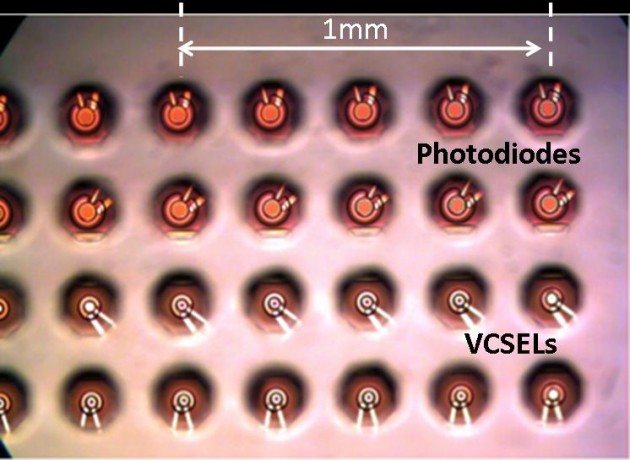IBM has been offering optical CPUs for some time now, currently available in systems such as Power 775 and Blue Gene supercomputers. A new modification, however, has enabled these optical processors, which transfer data through light instead of electrons, to reach speeds up to one terabit-per-second.
The proliferation of optical chips has been seen more and more in supercomputers, although the technology was virtually non-existent ten years ago. The most common use currently is in the interchange between racks of a supercomputer, but optical circuits are getting closer and closer to the CPU itself. This new technology, made by drilling forty-eight tiny holes in a CMOS chip, will bring light even closer to the CPU—a technology that is projected to eventually replace the electronic CPU altogether.
As these optical processors become more efficient and less costly to build, it won’t be long before we see them in high-end servers, and possibly, into our own personal desktops, laptops, maybe even mobile devices. Supercomputers are not the only platform where optics are seeing interest, and IBM is not the only company developing optic technologies.
Intel has made various developments in photonics over the past 3-4 years, beginning with the world record-breaking optical interconnect that was announced in late 2008, which boasted speeds equivalent to 340ghz. They made more headway in 2010 with the announcement of Light Peak, which has since brought 10Gbps interconnect speeds to everyday retail devices—without the optical component
Intel was able to achieve their 10Gbps speeds over copper wires, paving the way for Light Peak to hit the market as Thunderbolt. Since Intel was able to achieve the speeds they were looking for using a lower-cost copper solution, a faster optical solution remains in R&D. It will likely resurface in the near future as we continue to push the physical limits flinging electrons along a metal system.
The biggest problem comes when attempting to switch from electron data to light data. In order for a system to take advantage of some of these outstanding speeds, the entire system has to be designed to handle optical data throughput, so that converting to electrons and passing through copper are only necessary when massive speeds aren’t required. When this technology comes, it will be a complete revolution in the internal workings of computers as we know it.
The only practical use for optics right now is for moving data across long distances. Data throughput is still limited by the electron-based chips that convert optical data and pass it along to an internal processor, but the technology is already being used in wired networks. In the future, we will see the rise of more multi-band, serial data transfer technologies which will send and receive video, audio and network data through a single cable. With obvious uses for this technology in gaming devices, it’s likely that the gaming industry’s increasing demands will offer a segue between a hybrid of optical and electron data throughput, to the inevitable all-optic systems of the future.
Even with new developments in Quantum Computing, it won’t be long before the bottlenecks in our systems are inherent in the CPU itself. Once again, the fiercely competitive nature of the electronics industry will push our everyday devices beyond capabilities we can currently comprehend.








 Articles RSS
Articles RSS